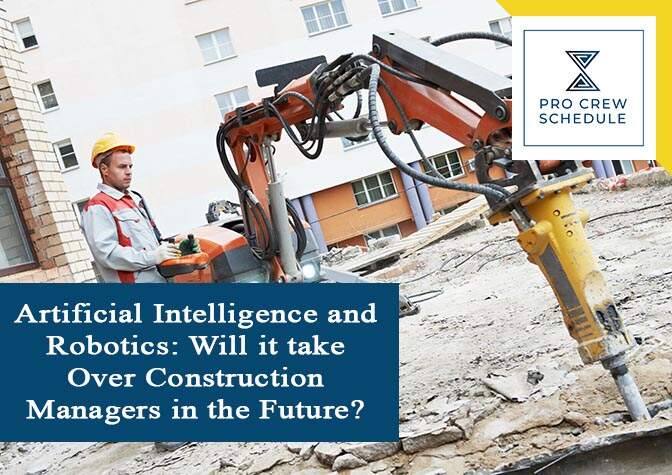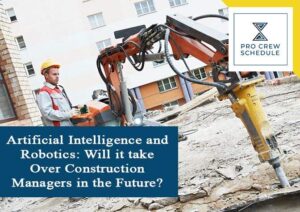The use of artificial intelligence and robotics is not new to the construction industry. Although this sector has acceded to traditional ways of getting things done, it has adapted to the emerging trends that AI (Artificial Intelligence) and Robotics have introduced over the years, especially in task management programs. Such include various construction scheduling software, which widely helped overall project management for construction managers.
But for construction managers to embrace the changes brought forth by continuous technology development, they first have to understand what it is and how it can improve effectiveness & efficiency in managing construction projects. So whether you are a construction manager yourself, an aspiring one, or just anyone interested in Artificial Intelligence and Robotics and its role in construction in our world, it would be better to know it. Furthermore, you should know how it is viewed to affect the industry & Construction Managers in the future.
Understanding Artificial Intelligence and Robotics
Many would consider using robotics and artificial intelligence to project task management for construction these days. But what are these two? Here’s a better understanding of it.
Defining Artificial Intelligence
It is the development of a computer system that must function how a human brain works in theory. It aims to achieve the performance of tasks that would typically require human intelligence, such as but not limited to speech or voice recognition, visual perception, and even the cognitive process of reaching a decision.
Defining Robotics
While AI is the development of a system, Robotics, on the other hand, is the actual construction and design of machines (robots) which would be used to carry out tasks that are usually done by human beings.
AI and Robotics: Its Relevance to the Construction Industry
People in the construction industry may not realize it yet, but Artificial Intelligence and Robotics have been very rampant ever since the technology was introduced to the world of humankind. Looking back, construction is one of human’s oldest occupations as people have been erecting shelters, building structures, and paving roadways to improve their means of daily living.
From harnessing manual labor to the usage of machines and equipment. And from labor-intensive planning and carrying out designs to digital preparation of blueprints and project scheduling, technology, particularly the use of AI and Robotics, has dramatically developed and shaped the construction sector in making human jobs more efficient, construction projects to be well organized, and building topnotch structures which have very high regard for safety.
Since AI and Robotics have already proven their value in making construction projects more efficient, construction companies have taken advantage of both in various ways. It could help them meet their goals and objectives, which in hindsight and looking at the overall perspective, could gain the competitive advantage among other players in the industry.
How AI & Robotics are currently being used in construction
AI and Robotics can be used in different phases of completing a construction project. AI and Robotics are still evident from the initial phase to its execution and even management after completion.
Accuracy and Consistency
The development of AI, which could run an assessment of a company’s previously completed projects, highlighting its success and identifying oversights and miscalculations, could help construction managers assess what process should be replicated and which functions to be avoided or be given much attention to. The algorithms provided by this AI would also enable data analysts to quickly draft task management programs without having to start from scratch all the time.
Design Processes
Artificial Intelligence can also aid in the design process by producing alternative designs that could help project managers weigh and find their best option. Several AI developed that uses generative design approach considered this design exploration process. It could sort out details within the user’s defined parameters, resulting in various options where project managers can easily choose from.
To Save Time
Some AI, such as Optical Character Recognition (OCR), will significantly enable project managers to save up on time and avoid the arduous task of manually typing or re-drawing documents. This type of technology is the solution to extract data from a printed file automatically. Perhaps, it’s for any written text from a scanned document. They may search drawings from a given image file, intending to allow the end-user to convert these documents and images into an editable and machine-readable form used in the data processing.
Capturing photos for comparison
The use of drones, which are essentially flying robots that can be remotely controlled through a system embedded in its body, is also not a new thing in the industry. It can capture an overhead view of job sites, inventories and raw materials, machinery, and even people, which would allow project managers to identify differences between what was planned versus the actual.
Derives Information to Engineers
During the ongoing construction, AI database systems were developed to inform and provide engineers with the best construction methodology based on its construction site, structure type, and likes. In addition, since AI can house previous projects of the firm and blueprints of the current plan, it can run information derived from these files to aid engineers in coming up with decisions based on factual evidence gathered in the system.
Attendance Monitoring
Gone were the days of manual clock-in and out, filing of leaves, using catalogs, and having to run after managers for manual signatures. Not just with the construction industry, but the world is indeed on the brink of complete digitization.
Once the project started, AI can be used for administrative project task management, such as identifying those who filed for sick days and automatically adjusting the workforce balance accordingly, which would assign tasks to other employees on the specified days where workforce is short.
Furthermore, Artificial Intelligence can also be installed in commercial and residential buildings, enabling guests to control lighting, room temperature, and audio-visual equipment in their rooms to their liking with ease.
Top Construction Robots Used Worldwide
Being one of the most labor-intensive jobs ever known, construction is also considered one of the least automated and digitized among other industry sectors. But with constant changing times come different innovations which aim to simplify jobs.
Being responsive to time and adaptive to changes are great factors for why construction firms have evolved to what it has become. Like with nearly every known job industry, the use of automated robots for this field is already being embraced. And a lot have been deployed to different construction sites all over the globe.
As the name implies, construction robots are automated machines that are designed to assist with various human tasks such as but not limited to demolition, surveying, and building structures.
While it is viewed as a threat for some, these robots are not developed to take over and replace the manual workforce; instead, they were created to aid and work with humans making their jobs more manageable and less exposed to harm.
Advanced Construction Robotics’ TyBot
This autonomous rebar-typing robot helps workers, particularly ironworkers, build bridges and decking for buildings. It works by installing it at a set point while being given a direction to move. With its machine vision feature, the robot can identify tie-points along the rebar grid, a signal for using wire to secure each identified point. The TyBot can perform 1,000 ties per hour which can cover seven or eight laborers.
Built Robotics
These are rather famous Robotics commonly known and observed at construction sites. These are autonomous heavy equipment with the likes of bulldozer, excavator, and compact track loader that can be programmed with coordinates to carry out tasks such as digging, grading, and pushing without a need for the worker to sit in a dusty cab for straight dreading hours.
Construction Robotics’ MULE135 and SAM100
These are robots that were innovated to help and support masonry workers notably. It functions by lifting heavy loads and bricklaying when those loads arrive. The use of these robots will unburden the manual labor workforce in carrying weights.
Hyperion Robotics’ 3D Printing System
It functions with the use of industrial-sized 3D printers for construction applications. It uses extruded cement to create different forms. It also has a feature of mechanical reinforcement, which places steel structures within printed elements. With Hyperion Robotics’ use of unique mixtures of concrete and recycled waste material customized to withstand different environments, its goal is to strengthen the 3D printed structure while also reducing waste.
Kewazo Smart Robotic Elevators
As its name suggests, this Robotic is an elevator designed to improve construction logistics at construction sites or industrial plants. Its primary focus is to strengthen scaffolding – specifically the assembly process – which would allow delivery of parts as needed at the correct assembly point. As per the review, this smart elevator help saves on costs, increase speed and safety, and deliver real-time data.
Key Takeaway
Construction managers are key personnel to the construction industry. While Artificial Intelligence and Robotics are products of technological advancements that are not seen to replace manual human labor, they improve their effectiveness and efficiency at work.
Even though AI and Robots can carry out specific tasks more accurately and with utmost precision compared to some of the output of manual labor, their function is limited to only the programs defined in their system. Without the intervention of human hands, AI and Robotics cannot decide to function on their own accord. Nevertheless, the human element will still play a vital role in the overall project management for construction.







